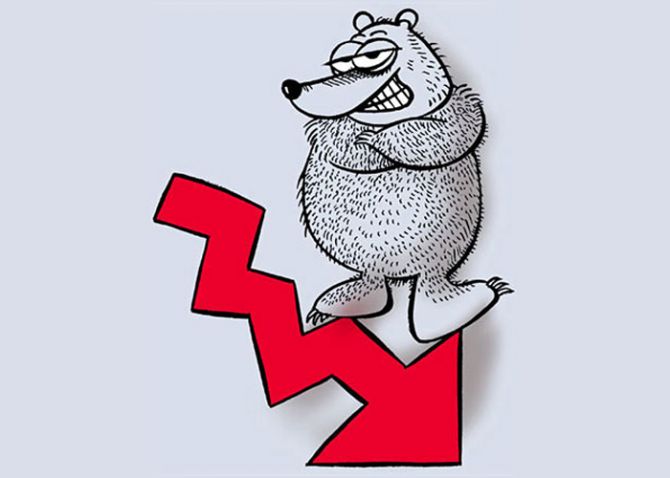The longer a bear market lasts, the more the eventual returns are, says Devangshu Datta.
Illustration: Uttam Ghosh/Rediff.com

It is an axiom that stocks are never fairly priced.
The theory of reflexivity states that when a big downtrend or uptrend starts, it is guaranteed to overshoot the fair price mark.
Most of the time, therefore, valuations are higher or lower than justified by fundamentals.
It is relatively easy for a long-term investor to handle a situation when stocks are undervalued: Keep investing in these stocks and rely on prices improving at some stage.
The longer a bear market lasts, the more the eventual returns are.
It is very hard to handle a situation where stocks are overvalued.
The investor can look for the rare undervalued stock or continue to invest in overvalued stocks that will see eventual deep corrections.
In such circumstances, traders can have a field day.
Traders will book profits and re-enter, going short if they deem necessary.
But a trader pays a large price for this flexibility, in terms of higher capital gains taxes and higher transaction costs.
Traders also use lots of leverage -- too much for comfort where most investors are concerned.
Even if over-valuation is correctly diagnosed, nobody knows when a trend will be exhausted. This is the real problem.
If you sell out early due to diagnosing over-valuation and the trend continues to run-up, you leave profits on the table.
If you sell out late, after the trend has reversed, you fail to book profits when those are available.
Many investors shrug and hold on through both up and down phases, relying on equity to beat inflation in the long run.
This is reasonable if the investor has also bought through both market phases.
Then, the over- and under-valuations average out to give good acquisition prices.
But an investor who has entered only during a phase of over-valuation could wait for a very long time for returns.
The data suggest the vast majority of India's retail investors bought a large portion of the portfolios at high valuations and their buying has driven valuations even higher.
The assets under management for equity mutual funds (MFs) and equity-linked savings schemes have expanded by Rs 1.8 lakh crore in the past 12 months.
In addition, retail investors have bought equity directly.
The retail investor has been partly responsible for driving valuations up across the entire equity spectrum, including in mid-caps and small-caps, with little institutional coverage.
Most of this buying has taken place at valuations of price to earnings (PE) 20-plus and PE 25-plus, well above the median long-term valuations of PE 17-18 for Indian equity.
Hence, the average retail investor is massively exposed to the next big correction.
There are several possible strategies for investors who have bought at high valuations.
One is to sit tight and/or continue systematically investing via MFs.
But, historically, investments made at current valuations have taken three to four years to get into the black, and even longer before beating returns from safer debt instruments.
Another strategy is to book some profits in equity and switch those allocations to debt funds.
This is a reasonable option now -- inflation remains low and consensus opinion suggests the Reserve Bank of India is likely to cut rates again.
Every cut will result in capital gains for a debt fund (and for banks) -- the value of a lender's portfolio rises every time there is a cut.
Such a rebalancing strategy retains an equity presence and is possibly the most rational action.
A third strategy would be to continue buying equity while setting stop-losses to stem the damage if there's a correction.
For example, the investor could decide to sell 20 per cent of the equity portfolio (and move the realised cash into debt funds) if there's a 10 per cent correction.
If the market falls another 10 per cent, the investor could sell another 20 per cent.
This can be done for individual stocks and for entire portfolios.
Such a method allows participation in the bull run, while being braced for a trend reversal.
The danger is, a small correction might induce a liquidation that foregoes future returns.
No given strategy will guarantee the best returns, but reasonable strategies will limit potential losses.
Investors must be aware of the potential danger and plan for the future.
Even if you decide to just sit tight for the moment, don't be an ostrich.
Be prepared to take action later if the trend changes.










